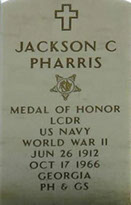


Personal Information


Jackson Charles Pharris was born June 26, 1912 in Columbus, Muscogee County, Georgia.
Following his Navy retirement, the Pharris family settled in Rolling Hills Estates in Los Angeles County. Pharris attended Long Beach City College and USC. On June 9, 1956 he graduated from USC with a Bachelor of Science in Commerce.
On October 16, 1966, while attending a Medal of Honor activity, Pharris collapsed and was taken to the Veterans Administration Hospital in Los Angeles where he died the next day of a heart attack. He is buried in Section 13, Grave 16281, at Arlington National Cemetery.
After his death, and the death of his wife, his Medal of Honor took a strange route where it was taken by the State of California as unclaimed property. When the family realized that his war medals were missing they had to mount an all out campaign to have the medals returned to the family in 2002.
Official Citation
For conspicuous gallantry and intrepidity at the risk of his life above and beyond the call of duty while attached to the U.S.S. California during the surprise enemy Japanese aerial attack on Pearl Harbor, Territory of Hawaii, 7 December 1941. In charge of the ordnance repair party on the third deck when the first Japanese torpedo struck almost directly under his station, Lt. (then Gunner) Pharris was stunned and severely injured by the concussion which hurled him to the overhead and back to the deck. Quickly recovering, he acted on his own initiative to set up a hand-supply ammunition train for the antiaircraft guns. With water and oil rushing in where the port bulkhead had been torn up from the deck, with many of the remaining crewmembers overcome by oil fumes, and the ship without power and listing heavily to port as a result of a second torpedo hit, Lt. Pharris ordered the shipfitters to counterflood. Twice rendered unconscious by the nauseous fumes and handicapped by his painful injuries, he persisted in his desperate efforts to speed up the supply of ammunition and at the same time repeatedly risked his life to enter flooding compartments and drag to safety unconscious shipmates who were gradually being submerged in oil. By his inspiring leadership, his valiant efforts and his extreme loyalty to his ship and her crew, he saved many of his shipmates from death and was largely responsible for keeping the California in action during the attack. His heroic conduct throughout this first eventful engagement of World War 11 reflects the highest credit upon Lt. Pharris and enhances the finest traditions of the U.S. Naval Service.
Service Record
He joined the United States Navy on April 25, 1933. In September 1933, he reported aboard the USS California as a gunner. He was assigned to the USS Mississippi until December 1940.
Pharris reported aboard the USS California in January 1941. The ship reached Pearl Harbor on November 8, 1941.On the day the Japanese attacked Pearl Harbor, Pharris was a Navy gunner on the battleship California, which was struck by two torpedoes.
Pharris, who was 29 at the time, risked his life to save several unconscious shipmates who were trapped in compartments flooded with water and oil. He passed out twice because of the noxious fumes. He also organized an effort to rush ammunition to the ship's anti-aircraft guns.
Medals and Awards
![]() Medal of Honor
Medal of Honor
![]() Navy Cross
Navy Cross
![]() Purple Heart
Purple Heart
Memorials
He died on October 17, 1966 in Los Angeles, California and is buried in Arlington National Cemetery, Arlington, Virginia.
The Navy honored Lt. Cmdr. Pharris shortly after his death with a Knox-class frigate that proudly carried his name from 1974 to 1992



Copyright 2013 Hilliard A Wilbanks Foundation








































